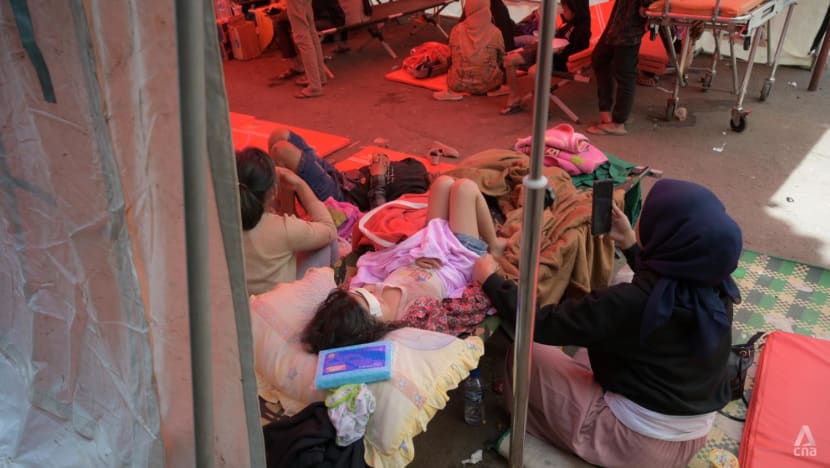‘Wait for me in heaven, my child’: Schoolchildren form the biggest casualties in West Java earthquake
As the earthquake occurred during school hours, children made up a significant portion of those killed and injured, West Java governor Ridwan Kamil said.

A school in Cianjur, Indonesia was badly damaged during a 5.6-magnitude quake on Nov 21, 2022. Several students were injured at this school. (Photo: CNA/Nivell Rayda)
CIANJUR, Indonesia: Rahman could not contain his emotion as medical workers carried his eight year-old daughter, Ina, out of the morgue and into an awaiting ambulance.
“My beautiful daughter,” he cried, staring at the blood-stained white shroud covering Ina’s lifeless body. “Wait for me in heaven, my child.”
The rest of his family also shed tears but Rahman’s cry was the loudest. The 31-year-old, who like many Indonesians goes by one name, decided to board the ambulance, not wanting to leave his daughter’s side as she was being transported to a family burial ground.
Rahman’s daughter was one of more than 250 people who were killed as a result of a 5.6-magnitude quake which jolted the Indonesian province of West Java on Monday (Nov 21).
The quake’s epicentre was in the mountainous region of Cianjur, about 75km southeast of the Indonesian capital of Jakarta.
More than 300 people were injured in the disaster, which also damaged at least 3,000 homes and buildings.
West Java governor Ridwan Kamil told a press conference on Monday evening that since the quake occurred during school hours, children made up a significant portion of those killed and injured.
“The majority of those who died were children … because it happened when children were at school,” the governor said. “We are still calculating the percentage, but reports on the ground consistently suggests that the majority (of the victims) were children.”
Related:
Related:
Lilies Suharyati said that when the quake happened, all she could think about was her two sons, Ridho, 10, and Ridwan, 7.
“I left the house immediately and headed straight to their school. I didn’t even bother to lock the doors or bring anything with me,” she told CNA on Tuesday.
The 30-year-old housewife said by the time she got to her sons’ school, she saw many pupils covered in blood and dust. Everyone, teachers and parents included, were sobbing uncontrollably from the shock and horror of the disaster.
The school, in the hilly, rural outskirts of Cianjur town, was deserted when CNA visited. A section of its outer walls had collapsed completely, while its classrooms were littered with debris and broken glass.
Hats belonging to students could be seen still hanging on one of the classroom’s walls and there was a glass containing a half-consumed drink on one of the teacher’s desks, hinting at the horror and panic caused by the tremor as everyone fled for their lives.
Suharyati said she could only find her eldest among the pupils. Her other son, Ridwan, was taken to a hospital for a broken wrist he sustained when a wooden cabinet fell on him.
Taking Ridho with her, Suharyati rushed to the hospital to find her injured son. The three have not been home since the quake.
NUMBER OF VICTIMS COULD RISE: GOVERNOR
Children made up a significant portion of the patients treated at Cianjur’s Sayang Public Hospital, the biggest hospital in the West Java regency. Some, like Ridwan, had broken bones while others had injuries on various parts of their bodies.
The hospital, which also sustained damage from the earthquake, had to erect makeshift tents on its parking lot to treat the influx of patients.
Those with more serious injuries were treated inside the building, with hospital beds occupying lobbies and hallways as the hospital experienced a shortage of rooms.

The streets leading to the hospital did not stop buzzing with the sounds of sirens as ambulances came and went non stop, bringing in new patients to the hospital before they were on their way again to respond to another emergency call.
The quake also triggered landslides and damaged roads, cutting off access to some parts of the regency. Governor Kamil believes the number of fatalities and those in need of medical treatment will rise as these areas become accessible to emergency services.
"There is a possibility that the number of victims will change as (more) evacuations are conducted," he said on Monday.
Meanwhile, Dwikorita Karnawati, chief of the Indonesian Meteorology, Climatology and Geophysics Agency, warned that the quake had increased the chances of landslides and flash floods especially given that Indonesia is still in the middle of the rainy season.
“(The quake) had caused soils to loosen and when coupled with heavy rain, can trigger landslides and flash floods. Residents and local governments must also anticipate the presence of collateral hazards as a result of (Monday’s) quake,” she said.














